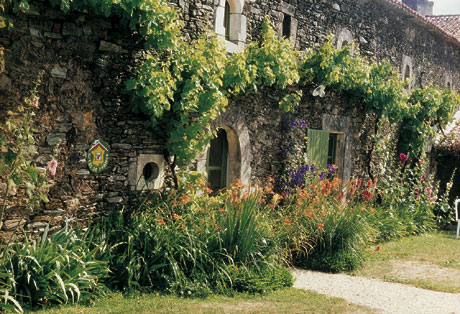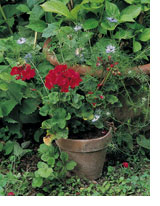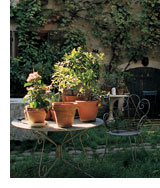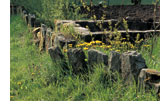- All About Animals
- The magazine for animal lovers.

- For a complimentary copy please telephone 0870 2406871
- Email the Editor

- Write with your opinion on the magazine and life in general after retirement. Click here.
- Register your vote
- Should workers be encouraged by their employers to stay on after retirement?

WORKING WITH FLOWERS - How to create a Jardin Paysan
When it comes to selecting which flowers to plant and where, observe the same rule as with garden planning: before visiting the nursery (pépinière) or garden centre (jardinerie), step back and think through the effect you would like to achieve. Here are a few suggestions to ponder:
 Avoid isolated borders of flowers on a lawn, bright and clashing colours or exotic species; this is not what a country garden is all about. It does, however, form part of the garden style in chateaux and large country mansions, where parterres of flowers were partly there to display the owner’s wealth and the skills of his gardeners.
Avoid isolated borders of flowers on a lawn, bright and clashing colours or exotic species; this is not what a country garden is all about. It does, however, form part of the garden style in chateaux and large country mansions, where parterres of flowers were partly there to display the owner’s wealth and the skills of his gardeners.
Plant flowers at the bottom of walls, in a slightly haphazard way. This works very well and looks natural with old stone walls. So you could, for example, put in some bushy flowers with fairly subtle and coordinated colours, with a neat edging of box, stones or bricks, or a low wooden fence. Hardy perennials, such as peonies, garden pinks, iris, asters and helianthus, will look after themselves year after year.
Put flowers in pots, either plain terracotta or more colourful old ceramic ones collected over the years, and place them around the entrance to the house, on window sills, steps, or walls. This will allow you to cultivate some of the more fragile species, or position small flowers (such as pansies, petunias or carnations) in more favourable spots and move them around to suit your mood.
 Gather woodland flowers and plant them under trees, letting them come up in a natural, random way. Typical examples are: daffodils, violets and lily of the valley. Flowers will also look great in the vegetable garden, adding a bit of colour to the greenery, while also helping to ward off certain species of harmful insects.
Gather woodland flowers and plant them under trees, letting them come up in a natural, random way. Typical examples are: daffodils, violets and lily of the valley. Flowers will also look great in the vegetable garden, adding a bit of colour to the greenery, while also helping to ward off certain species of harmful insects.
Give flowers time to settle in and find their favourite spot. This allows you to determine which combinations of species work best together. Then you can start to intervene - don’t be afraid of taking cuttings or transplanting elsewhere in the garden, or experimenting with seeds to see where plants are happiest.
Don’t forget the small garden at the front, by the roadside. If the front or side of your house is by the road, don’t forget the thin strip of land that runs alongside it. A few plants will brighten up this often neglected area, particularly if the pavement has been covered in asphalt and appears quite dull. And this need not be painstaking work: throw a few hollyhock seeds in a hole dug near the wall and watch how quickly and tall they grow!
 Window boxes are good if you have a town or village house, but ideally choose terracotta ones and get a good mix of plants. Plant something to climb up the wall, especially in a village house, so that you can help to contribute some greenery to the street.
Window boxes are good if you have a town or village house, but ideally choose terracotta ones and get a good mix of plants. Plant something to climb up the wall, especially in a village house, so that you can help to contribute some greenery to the street.
Choose decorative flowers that are easy to look after, simple and robust, but let wild flowers take root too: meadow flowers on open ground; brightly coloured clumps of perennials for borders; and creeping or rockery flowers that can take hold between paving or stonework. However, while you should let nature express itself, you will also need to exercise some element of control or your garden could turn into a jungle.
 If you want to nudge more of nature into your garden, try transplanting wild flowers, but you will need to make sure that you use local specimens and that you plant them in a site where the conditions are similar to those where they would be growing in the wild. And remember that some of these are protected species. To find out which, consult your local botanical association by asking at the nearest tourist office.
If you want to nudge more of nature into your garden, try transplanting wild flowers, but you will need to make sure that you use local specimens and that you plant them in a site where the conditions are similar to those where they would be growing in the wild. And remember that some of these are protected species. To find out which, consult your local botanical association by asking at the nearest tourist office.
This extract was taken from ‘How to Create a Jardin Paysan’ by Louise Ranck, by kind permission of Ascent Publishing Ltd.
